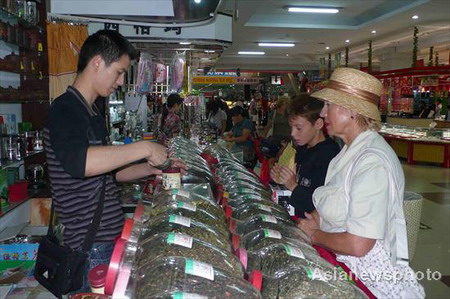
|
BIZCHINA> Industries
 |
|
Trade: New guidelines aim to brew more, better tea exports
By Xie Yu (China Daily)
Updated: 2008-09-16 10:41
 Growing and brewing tea was elevated to an art form by Lu Yu of the Tang Dynasty (AD 618-907), whose treatise is considered the bible of tea culture throughout Asia. But the new government guidelines for growers and processors, to be released on October 1, are not about sipping tea in a pavilion by a lily pond - they are serious business. Tea is one of China's major export commodities. The country shipped 151,000 tons of tea worth a total of $344 million to overseas markets in the first half of this year, up 5.49 percent year-on-year. Officials and analysts said that if planters and processors improve the quality of their tea, they could not only sell more but also boost profit margins. For instance, Chinese tea is sold at an average of $2.27 a kg - 60 percent cheaper than Sri Lankan tea. The appreciating renminbi is also undermining local exporters' competitiveness and rising fertilizer, labor and transport costs are trimming profits. The only way for local tea planters and processors to compete and stay profitable is to improve quality, industry analysts said. "If China wants to make a breakthrough in tea exports, it must put more effort into quality control," Zhu Zhonghai, director of the China Tea Marketing Association's information department, said. Stricter inspections in markets such as Japan and the European Union on imported tea and other produce is adding to the pressure. From 2009, Japan's list of inspection items will increase to 144 from 83. Not all Chinese tea exports will meet those standards. The country's inspection system is currently limited to checking harmful chemical levels. The new guidelines will be far more comprehensive, industry sources said. Although they will not be compulsory, it is expected that planters and processors will abide by them because of the benefits they will bring. "If exporters follow the new guidelines and give instructions to the tea planters and processors, they will be able to regulate their production process and avoid export risks," Li Jia, who has worked for a tea exporter for three years, said. The guidelines will be adjusted down the track and could eventually become compulsory, Zhu said. But some tea exporters said their products already meet the most stringent foreign import requirements. "I have heard of the new document, but since it's not compulsory, it might not affect us," Jiang Wei, of the Shanshan Tea Co in Zhejiang province, said. Shanshan Tea has three factories and several tea gardens. Jiang said the tea producer communicates directly with its clients - most of whom accept the existing standards - and directs its growers accordingly. China is the world's biggest tea producer, but it is the fourth largest tea exporter. Zhu said poor marketing is holding back growth. "China does have quality tea," Zhu said. "But compared with bigger exporters like Sri Lanka and India, we haven't been as active when it comes to promoting local teas." Sri Lankan and Indian producers have successfully promoted their strong black teas to foreign markets, but China's tea culture remains relatively unknown, Zhu said.
(For more biz stories, please visit Industries)
|